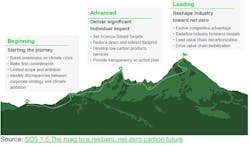Schneider Sustainability Framework Offers Roadmap for Climate Response
At DCF we’ve noted how the leading data center and cloud computing companies are stepping up their sustainability efforts. Leadership matters, but there’s not always a clear roadmap on how smaller companies can adapt the innovation strategies of hyperscale operators.
If the world is to address climate change, that sustainability gap must be addressed, and not just by large companies. Pankaj Sharma of Schneider Electric says the need for a broad-based response has been heightened by two trends – the shrinking window for climate action, and the acceleration of the global shift to a digital economy.
“If you look at the IPCC (United Nations’ climate report), we have basically just the next decade for drastic action,” said Sharma. “The other big challenge is that there’s a whole heap of digitalization happening. In the next 20 years, the need for data centers will double.
“How do we make sure that this is sustainable?” asked Sharma, the Executive Vice President of the Secure Power Division at Schneider Electric. “There’s a lot of talk, but when it comes down to measuring impact, that’s a very difficult question.”
Schneider Electric hopes to spark a collective response from the data center industry. The global energy services company recently released a sustainability framework to help data center users identify, measure and manage their carbon impact.
Sustainability has many components, including facility design, energy efficiency, use of power and water, sourcing renewable energy, waste management and recycling, an many more. That makes it hard to develop climate responses that address the full scope of an organization’s environmental impact.
“Environmental sustainability reporting is a growing focus for many data center operators,” said Sharma. “Yet, the industry lacks a standardized approach for implementing, measuring, and reporting on environmental impact. Our intention with this framework is to improve benchmarking and progress toward environmental sustainability to protect natural resources for future generations.”
Adoption of Metrics Lags in Key Categories
Schneider’s framework reflects the growing recognition that the cloud computing sector must step up its efforts on climate change to help safeguard the future of the planet.
Schneider offers standardized metrics to guide operators and the industry at large. creating a flexible roadmap that organizations can use to assess their status. The framework, the Guide to Environmental Sustainability Metrics for Data Centers, identifies categories of climate impact, and metrics in each area that can be used in target setting, reporting, and certifying environmental impact.
“We need a common understanding that looks at the entire energy footprint, including PUE, greenhouse gases, water waste, and land and biodiversity,” said Sharma. “This is based on our experience. We have to start somewhere for a common for common ground. It’s really about the stage that you pick.”
The framework outlines which metrics each company can adopt and track, based on their current capabilities and future goals.
Schneider Electric’s framework was developed by its Energy Management Research Center, which sought input from ESG experts, sustainability consultants, data center scientists, and solution architects, with a goal of “taking the guesswork out of measurement and reporting” – a key step in equipping operators to instrument and document their IT operations.
“You can’t have an impact on what you don’t measure,” said Rob Brothers, Program Vice President for the Datacenter and Support Services Program at IDC. “Companies must establish clear and consistent metrics that account for not only efficient technology, but also the consumption (or possible destruction) of natural resources such as water, land and biodiversity.”
For years, the data center industry’s primary “green” metric has been power usage effectiveness, or PUE, which was developed in 2007 by industry consortium The Green Grid to provide a benchmark for energy efficiency. Over the years, it has become broadly embraced, with about 70 percent of data center operators tracking PUE, according to recent data from The Uptime Institute. Growing concern about water scarcity has prompted action, with about 51% percent of data centers now tracking their water usage.
But the numbers drop off after that. Although many large companies track carbon and greenhouse gas (GHG) emissions as part of corporate responsibility initiatives, the Uptime survey found that just 33% of data center operators are tracking IT or data center carbon emissions. Just 25% of users track the e-waste and recycling of their IT equipment.
This disparity is why Schneider has structured its framework for organizations at multiple phases of the sustainability journey, who can choose their entry point for a structured way to implement metrics that allow them to track their impact and make meaningful progress.
Schneider includes a category for Land and Biodiversity, noting that “data centers have a direct impact on the land they are built upon and an indirect land impact from their supply chain.” This will become an important metric as more data centers adopt on-site energy sources such as solar arrays and generation.
“The ability to measure energy, greenhouse gases and water is more common than on waste, and land and biodiversity,” said Sharma. “It’s easier to measure these things than the carbon impact of who you’re selling to and who you’re buying from (in scope 3 emissions tracking).”
Thought Leadership to Drive Change
Sharma acknowledges that addressing the climate crisis is a huge challenge, made increasingly difficult by the shrinking timelines for action. But he also believes that many operators are ready to act, and seeking guidance on the best path forward.
“We are in the very early stages,” he said. “We are going to our customers with these measures and having conversations. They want something like this.”
In the meantime, Schneider is using its global reach to try and drive change. The Paris-based company has a long history of engagement and impact on climate. It introduced a Sustainability barometer in 2005, and estimates that it has saved customers 120 million tons in CO2 emissions since then.
“We are a very purpose driven company,” said Sharma. “For us, it’s a thought leadership piece. We’re sharing this framework with our larger customers and we’re talking about it at conferences. Now we’re working with the analyst community and seeking help from those with a strong voice in the industry. We feel very confident about the technical capabilities and science-based approach.
“The key question is where is the pivot?” asked Sharma. “If we only have 10 years, are we going to apply this now? I feel positive. The appreciation of the challenge is almost 100% Now, only half the world is applying it. The new generation will be really important.”






